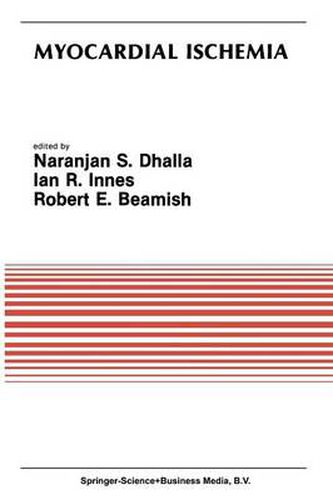Readings Newsletter
Become a Readings Member to make your shopping experience even easier.
Sign in or sign up for free!
You’re not far away from qualifying for FREE standard shipping within Australia
You’ve qualified for FREE standard shipping within Australia
The cart is loading…






This title is printed to order. This book may have been self-published. If so, we cannot guarantee the quality of the content. In the main most books will have gone through the editing process however some may not. We therefore suggest that you be aware of this before ordering this book. If in doubt check either the author or publisher’s details as we are unable to accept any returns unless they are faulty. Please contact us if you have any questions.
Whenever the coronary flow is inadequate to provide enough oxygen to meet the energy demands of the tissue, the heart becomes ischemic. Manifestations of myocardial ischemia include depression in contractile activity, changes in metabolic pattern, abnormalities in ultrastructure, and alterations in membrane potential. Ischemic changes during the early phase are reversible but as the period of ischemia is extended, the injury becomes irreversible. The transition from reversible to irreversible ischemic injury is usually associated with some membrane defects. It is worthwhile to consider that the irreversible damage to the ischemic myocardium occurs when the sarcolemmal membrane is altered in suoh a way that it would promote 2 a net gain of ca + in the cardiac cell upon reinstitution of blood flow. Suoh a lesion could result when mechanisms for the entry as well as removal 2 of ca + from the myocardial oell become defective. In this regard, 2 depression of the sarcolemmal ca + pump would favour the oocurrenoe of 2 intracellular ca + overload. Furthermore, inhibition of the Na+-K+ pump would lead to elevation of myoplasmic Na+ which oould then increase the 2 2 intracellular concentration of ca + through the sarcolemmal Na+-ca + exchange mechanism. In faot recent studies have revealed an inhibition of 2 the sarcolemmal Na+-ca + exchange mechanism in the ischemic heart and this 2 change could also contribute towards the occurrence of intracellular ca + 2 overload.
$9.00 standard shipping within Australia
FREE standard shipping within Australia for orders over $100.00
Express & International shipping calculated at checkout
This title is printed to order. This book may have been self-published. If so, we cannot guarantee the quality of the content. In the main most books will have gone through the editing process however some may not. We therefore suggest that you be aware of this before ordering this book. If in doubt check either the author or publisher’s details as we are unable to accept any returns unless they are faulty. Please contact us if you have any questions.
Whenever the coronary flow is inadequate to provide enough oxygen to meet the energy demands of the tissue, the heart becomes ischemic. Manifestations of myocardial ischemia include depression in contractile activity, changes in metabolic pattern, abnormalities in ultrastructure, and alterations in membrane potential. Ischemic changes during the early phase are reversible but as the period of ischemia is extended, the injury becomes irreversible. The transition from reversible to irreversible ischemic injury is usually associated with some membrane defects. It is worthwhile to consider that the irreversible damage to the ischemic myocardium occurs when the sarcolemmal membrane is altered in suoh a way that it would promote 2 a net gain of ca + in the cardiac cell upon reinstitution of blood flow. Suoh a lesion could result when mechanisms for the entry as well as removal 2 of ca + from the myocardial oell become defective. In this regard, 2 depression of the sarcolemmal ca + pump would favour the oocurrenoe of 2 intracellular ca + overload. Furthermore, inhibition of the Na+-K+ pump would lead to elevation of myoplasmic Na+ which oould then increase the 2 2 intracellular concentration of ca + through the sarcolemmal Na+-ca + exchange mechanism. In faot recent studies have revealed an inhibition of 2 the sarcolemmal Na+-ca + exchange mechanism in the ischemic heart and this 2 change could also contribute towards the occurrence of intracellular ca + 2 overload.